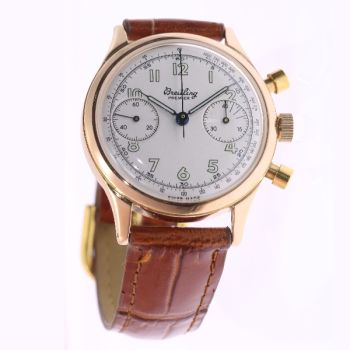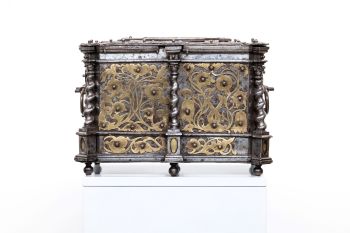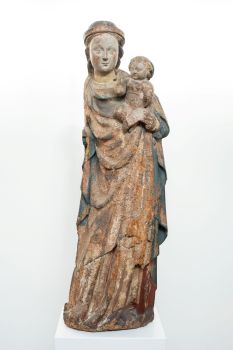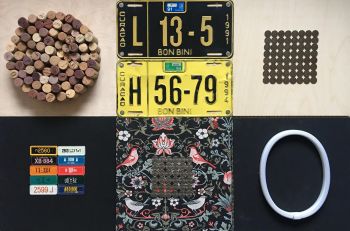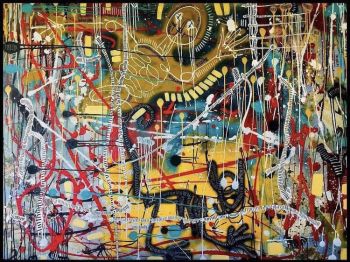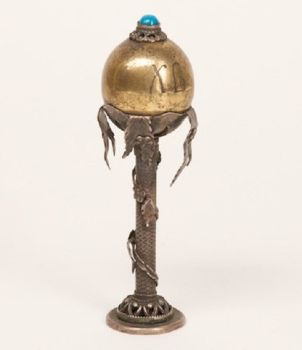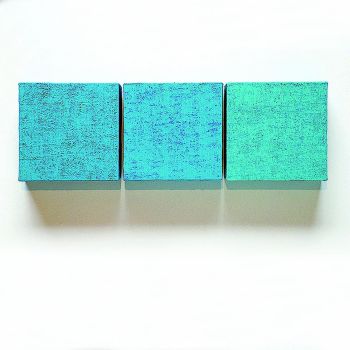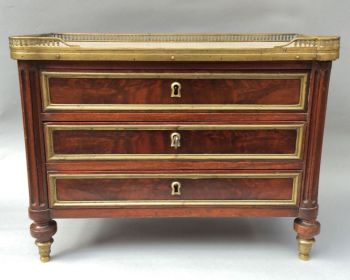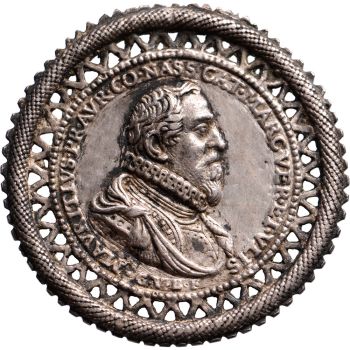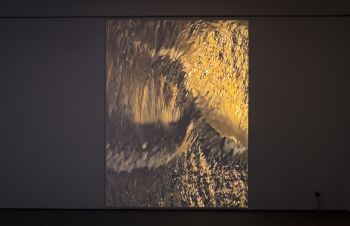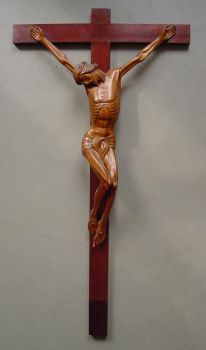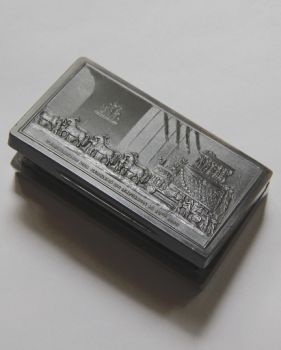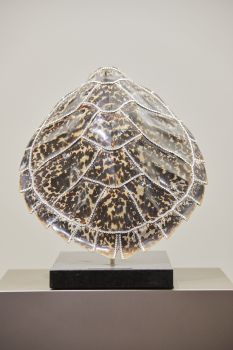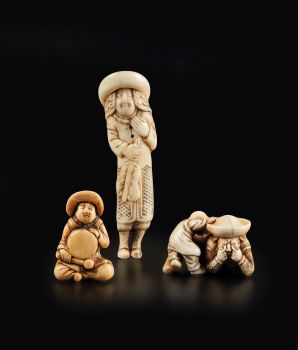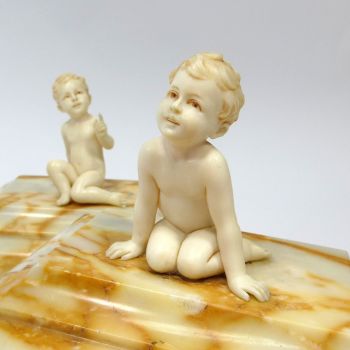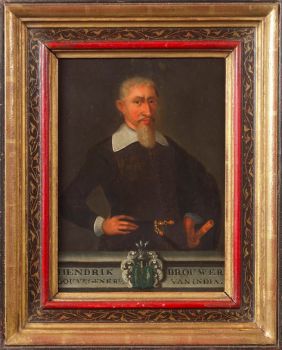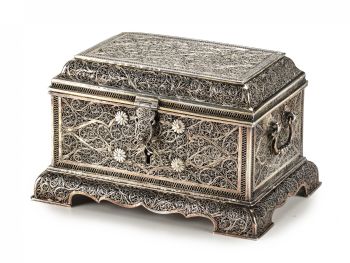A British-colonial Jamaican engraved tortoiseshell comb-case with silver mounts and a comb 1690
Artista Sconosciuto
ossoConchiglia
16 ⨯ 10 cm
Prezzo su richiesta
Zebregs & Röell - Fine Art - Antiques
- A proposito di opere d'arteA British-colonial Jamaican engraved tortoiseshell comb-case with silver mounts and a comb
Jamaica, Port Royal, dated 1690, the case attributed to Matthew Comberford (act. 1688-1692), the comb to Paul Bennett (act. 1670-1692)
The case is inscribed PORT: ROYAL IN IAMICA: 1690 above the coat-of-arms of Jamaica. The reverse with native fruit trees, the corners with silver panels engraved with flowers, with a double-sided tortoiseshell comb, similarly engraved.
H. 16 x W. 10.2 x D. 1.1 cm (case)
Provenance:
Architect Thomas Wallis (1873–1953), who designed the Tate Gallery, London; thence by descent
Gifted to the previous owner by the son of Wallis in the 1970s
Jamaican Engraved Tortoiseshell
A Beautiful but Poignant expression.
After England’s conquest of Jamaica on the Spanish colonists in 1655, Port Royal developed into a large city and the thriving commercial centre of (the then archipelago) Jamaica. However, this all ended when a massive earthquake devastated the city and swept two-thirds of it under the sea in 1692. Combs made of materials such as ivory, wood, and horn were quite common in medieval and early modern Europe and a well-known status symbol. These tortoiseshell combs are objects created from familiar forms to reflect new cultural structures in a quickly changing society.
‘INDUS UTERQUE SERVIET UNI’
Taken home after the ‘colonial adventure’ as mementoes of Jamaica, they proved their owner’s worldliness and newly gathered fortunes by perfectly balancing the ‘exotic’ and the familiar, thus being a tool to obtain a higher social status upon arrival. The tortoiseshell was engraved with tulips and sunflowers, inspired by late-17th-century English embroidery. Often, they are engraved with the new coat-of- arms of Jamaica as well. These were granted in 1662, seven years after Britain seized the island in 1655 by Admiral William Penn and General Robert Venables and eight years before Spain’s official recognition of British claim to the island in the Treaty of Madrid, 1670. The arms are often combined with crops that – together with the labour of enslaved people (African and Indigenous) - made the economy thrive, such as sugar cane, cotton, fruit trees and coconut palms. Prior to Jamaica securing independence in 1962, the coat-of-arms reflected the Latin motto “INDUS UTERQUE SERVIET UNI” meaning “The two Indians will serve as one”. This refers to the collective servitude of the Taino and Arawak Indigenous to the British colonisers. The combs taken to England as a ‘souvenir’, therefore, also served as propaganda of the colonial ideas.
The narrow-toothed comb probably was intended for extracting lice, and the wide-toothed comb was for fixing wigs. It seems, however, that they were not for use but for show and display only. These combs could have been made for clients of mixed descent. However, it is known that British company officials often had children with one or more of their enslaved women. These children would become an integral part of upper-class society and would sometimes even move to England. Such an elaborate culture of comb-making might well be connected to the African roots of this community.
The Hawksbill Turtle’s shell was a widely used material and can be regarded as plastic avant la lettre, having the ability to bend when heated. These turtles were common in the oceans until they were hunted down almost to extinction, only to be (successfully) protected in the 20th century. This set is a beautiful but poignant expression of a painful cultural moment. Bought with wealth generated by enslaved Africans and indigenous peoples, it embodies the English appreciation of Jamaica’s glorious culture and natural history and the simultaneous savaging of it.
Attribution: Bennett or Comberford?
The Institute of Jamaica in London has eleven tortoiseshell combs, one large box with combs and one powder box. The first comb for the Institute of Jamaica in London was purchased by members of the West India Committee in 1923. It was described by H.M. Cundall in the West India Committee Circular from 1923 as “probably one of the earliest art objects made in the British West Indies displaying European influence.” The tortoiseshell works in the Jamaica Institute’s collection are thought to be from the hands of two craftsmen working in Port Royal between circa 1671-1684 and 1688- 1692, respectively. The present box is linked to the first group. Philip Hart, in his article Tortoiseshell Comb Cases, for the Jamaica Journal, reveals that research found an Englishman called Paul Bennett, in Port Royal, listed in 1673 as a comb maker.Therefore, it’s likely that Bennett was the maker of this first group, and an apprentice or assistant was the maker of the second group. Other works supposedly by Paul Bennett include the Sir Cuthbert Grundly comb case, dated 1672, a round powder box lid and comb case in a private U.S. collection, dated 1677, and the ‘Lady Smith’ casket, which is considered the artist’s masterpiece.
The earliest known comb-case with two combs, inscribed Sarah Henley and dated 1670, was sold by us in 2023 and can now be found in the collection of the Houston Museum of Fine Arts (see: Guus Röell & Dickie Zebregs, Uit Verre Streken, March 2023, p. 43, no. 14).
New research by Ms. Jade Lindo, a V&A/RCA History of Design MA student 2021-22, proved that the other craftsman making tortoiseshell combs was Matthew Comberford. Most boxes, cases and combs have a very particular style of engraving, but the present comb case with silver mounts shows a whole different style. Hence, it could have been made by Bennett’s colleague-comb maker Comberford – and the pun was probably intended. Another comb-case of the same quality and style, but dated 1688, was sold in New York in 2018. Remarkably, the comb in this case, too, was different in style than the case itself, which might point towards a cooperation between Bennett and Comberford of some sort. Did they own the company together, or was Comberford perhaps the successor of the business?
Literature:
Philip Hart, ‘Tortoiseshell Comb Cases: a 17th century Jamaican Craft’ in Jamaica Journal, the quarterly journal of the Institute of Jamaica, Vol 16, No 3, August 1983
H.M. Cundall, “Early Jamaican Handicraft”, in: The West India Committee Circular, 29th March, 1923
Frank Cundall, “Tortoiseshell carving in Jamaica”, in: The Connoisseur, July 1925, p.154
Frank Cundall, Tortoiseshell - Carving: A Notable Specimen in Jamaica, London, National Art Library, 1929
Jen Cruse, “Colonial Craftsmanship in Jamaica, in America in Britain” in: Journal of the American Museum in Bath, XXXIX, pp.18-25
Evelyn Haertig, Antique Combs and Purses, Carmel CA, Gallery Graphics, 1983
Donald F. Johnson, “From The Collection” in: Winterthur Portfolio, 43,2009, pp. 313- 334 - A proposito di opere artista
Può succedere che un artista o un creatore sia sconosciuto.
Alcune opere non sono determinate da chi sono state realizzate o sono state realizzate da (un gruppo di) artigiani. Esempi sono statue dell'antichità, mobili, specchi o firme non chiare o leggibili ma anche alcune opere non sono affatto firmate.
Inoltre puoi trovare la seguente descrizione:
•"Attribuito a …." A loro avviso probabilmente opera dell'artista, almeno in parte
•“Studio di ….” o “Officina di” A loro avviso un'opera eseguita nello studio o nella bottega dell'artista, eventualmente sotto la sua supervisione
•“Cerchio di…” A loro avviso un'opera del periodo dell'artista che mostra la sua influenza, strettamente legata all'artista ma non necessariamente al suo allievo
•"Stile di..." o "Seguace di..." A loro avviso un'opera eseguita nello stile dell'artista ma non necessariamente da un allievo; può essere contemporaneo o quasi contemporaneo
•“Modalità di…” A loro avviso un'opera nello stile dell'artista ma di epoca successiva
•"Dopo …." A loro avviso una copia (di qualsiasi data) di un'opera dell'artista
•“Firmato…”, “Datato…” o “Iscritto” A loro avviso l'opera è stata firmata/datata/inscritta dall'artista. L'aggiunta di un punto interrogativo indica un elemento di dubbio
•"Con firma....", "Con data...", "Con iscrizione..." o “Riporta firma/data/iscrizione” a loro avviso la firma/data/iscrizione è stata aggiunta da qualcuno diverso dall'artista
Sei interessato ad acquistare questa opera d'arte?
Artwork details
Related artworks
Artista Sconosciuto
Medieval Maria with child sculpture1450
Prezzo su richiestaRemco van Leeuwen Antiquair
1 - 4 / 12Artista Sconosciuto
A Surinam-themed Amsterdam long-case clock1746 - 1756
Prezzo su richiestaZebregs & Röell - Fine Art - Antiques
 A cura di
A cura diGallerease Magazine
Joseph Savart
Four portraits of women of Guadeloupe1769
Prezzo su richiestaZebregs & Röell - Fine Art - Antiques
Hubert Vos
Ritratto di un punjabi nell'India britannica1898
Prezzo su richiestaZebregs & Röell - Fine Art - Antiques
Thea G.F. Eschauzier
Ritratto di una ragazza giavanese1931
Prezzo su richiestaZebregs & Röell - Fine Art - Antiques
Artista Sconosciuto
A superb Indonesian royal gem-set gold overlaid silver betel box19th century
Prezzo su richiestaZebregs & Röell - Fine Art - Antiques
Artista Sconosciuto
Japanese transition-style lacquer coffer 1640 - 1650
Prezzo su richiestaZebregs & Röell - Fine Art - Antiques
Artista Sconosciuto
A Dutch colonial Indonesian betel box with gold mounts1750 - 1800
Prezzo su richiestaZebregs & Röell - Fine Art - Antiques
1 - 4 / 24Artista Sconosciuto
Uovo di Pasqua di presentazione russo d'argento1880 - 1899
Prezzo su richiestaH.W.C. Dullaert Art & Antiques Dealer
Rene Rietmeyer
"USA South Florida January 2006"2006
Prezzo su richiestaEuropean Cultural Centre Collection
Artista Sconosciuto
Antica icona russa in legno: Arcangelo Gabrieleearly 17th
Prezzo su richiestaKunsthandel H.W.C. Dullaert Icons
Artista Sconosciuto
A white jade ‘Lotus Seedpod and Bug’ carving, Qing dynasty, 18th century18th century
Prezzo su richiestaMenken Works of Art
1 - 4 / 24Artista Sconosciuto
UN NETSUKE MARINO IN AVORIO DI UN OLANDESE CHE TIENE UN FAN . CINESE18th century
Prezzo su richiestaZebregs & Röell - Fine Art - Antiques
Artista Sconosciuto
A Dutch colonial Indonesian betel box with gold mounts1750 - 1800
Prezzo su richiestaZebregs & Röell - Fine Art - Antiques
Artista Sconosciuto
Olandesi in miniatura18th century
Prezzo su richiestaZebregs & Röell - Fine Art - Antiques
Artista Sconosciuto
UN RARO SADELI INDIANO COMPLETO DI LAVORO E SCRITTURA INTARSIATI1800 - 1850
Prezzo su richiestaZebregs & Röell - Fine Art - Antiques
Artista Sconosciuto
A gem-set ivory sculpture of an Ottoman sultan1700 - 1750
Prezzo su richiestaZebregs & Röell - Fine Art - Antiques
1 - 4 / 24Artista Sconosciuto
UN MODELLO GIAPPONESE DI UN NORIMONO, UN PALANQUIN1650 - 1700
Prezzo su richiestaZebregs & Röell - Fine Art - Antiques
Artista Sconosciuto
A Kayapo Amazon Indigenous feather headdress1950 - 1960
Prezzo su richiestaZebregs & Röell - Fine Art - Antiques
Artista Sconosciuto
UN NETSUKE IN AVORIO DI UN OLANDESE CHE GIOCA CON UN RAGAZZINO18th century
Prezzo su richiestaZebregs & Röell - Fine Art - Antiques
 A cura di
A cura diDanny Bree
Wolfgang Hugo Rheinhold
“Eritis sicut Deus”1900 - 1950
Prezzo su richiestaZebregs & Röell - Fine Art - Antiques
Hubert Vos
Ritratto di un punjabi nell'India britannica1898
Prezzo su richiestaZebregs & Röell - Fine Art - Antiques
Artista Sconosciuto
A rare Japanese export lacquer medical instrument box1650 - 1700
Prezzo su richiestaZebregs & Röell - Fine Art - Antiques
1 - 4 / 12








